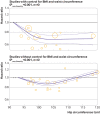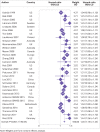Central fatness and risk of all cause mortality: systematic review and dose-response meta-analysis of 72 prospective cohort studies
- PMID: 32967840
- PMCID: PMC7509947
- DOI: 10.1136/bmj.m3324
Central fatness and risk of all cause mortality: systematic review and dose-response meta-analysis of 72 prospective cohort studies
Abstract
Objective: To quantify the association of indices of central obesity, including waist circumference, hip circumference, thigh circumference, waist-to-hip ratio, waist-to-height ratio, waist-to-thigh ratio, body adiposity index, and A body shape index, with the risk of all cause mortality in the general population, and to clarify the shape of the dose-response relations.
Design: Systematic review and meta-analysis.
Data sources: PubMed and Scopus from inception to July 2019, and the reference lists of all related articles and reviews.
Eligibility criteria for selecting studies: Prospective cohort studies reporting the risk estimates of all cause mortality across at least three categories of indices of central fatness. Studies that reported continuous estimation of the associations were also included.
Data synthesis: A random effects dose-response meta-analysis was conducted to assess linear trend estimations. A one stage linear mixed effects meta-analysis was used for estimating dose-response curves.
Results: Of 98 745 studies screened, 1950 full texts were fully reviewed for eligibility. The final analyses consisted of 72 prospective cohort studies with 2 528 297 participants. The summary hazard ratios were as follows: waist circumference (10 cm, 3.94 inch increase): 1.11 (95% confidence interval 1.08 to 1.13, I2=88%, n=50); hip circumference (10 cm, 3.94 inch increase): 0.90 (0.81 to 0.99, I2=95%, n=9); thigh circumference (5 cm, 1.97 inch increase): 0.82 (0.75 to 0.89, I2=54%, n=3); waist-to-hip ratio (0.1 unit increase): 1.20 (1.15 to 1.25, I2=90%, n=31); waist-to-height ratio (0.1 unit increase): 1.24 (1.12 to 1.36, I2=94%, n=11); waist-to-thigh ratio (0.1 unit increase): 1.21 (1.03 to 1.39, I2=97%, n=2); body adiposity index (10% increase): 1.17 (1.00 to 1.33, I2=75%, n=4); and A body shape index (0.005 unit increase): 1.15 (1.10 to 1.20, I2=87%, n=9). Positive associations persisted after accounting for body mass index. A nearly J shaped association was found between waist circumference and waist-to-height ratio and the risk of all cause mortality in men and women. A positive monotonic association was observed for waist-to-hip ratio and A body shape index. The association was U shaped for body adiposity index.
Conclusions: Indices of central fatness including waist circumference, waist-to-hip ratio, waist-to-height ratio, waist-to-thigh ratio, body adiposity index, and A body shape index, independent of overall adiposity, were positively and significantly associated with a higher all cause mortality risk. Larger hip circumference and thigh circumference were associated with a lower risk. The results suggest that measures of central adiposity could be used with body mass index as a supplementary approach to determine the risk of premature death.
© Author(s) (or their employer(s)) 2019. Re-use permitted under CC BY-NC. No commercial re-use. See rights and permissions. Published by BMJ.
Conflict of interest statement
Competing interests: All authors have completed the ICMJE uniform disclosure form at www.icmje.org/coi_disclosure.pdf and declare: no support from any organisation for the submitted work; no financial relationships with any organisations that might have an interest in the submitted work in the previous three years; no other relationships or activities that could appear to have influenced the submitted work; TAK reports grants from Canadian Institutes of Health Research, grants from International Life Sciences Institute, grants from National Honey Board, personal fees from Calorie Control Council, outside the submitted work.
Figures













Comment in
-
Tackling obesity in South East Asia.BMJ. 2020 Oct 15;371:m3960. doi: 10.1136/bmj.m3960. BMJ. 2020. PMID: 33060107 No abstract available.
References
-
- Kok P, Seidell JC, Meinders AE. [The value and limitations of the body mass index (BMI) in the assessment of the health risks of overweight and obesity]. Ned Tijdschr Geneeskd 2004;148:2379-82. - PubMed
Publication types
MeSH terms
LinkOut - more resources
Full Text Sources
